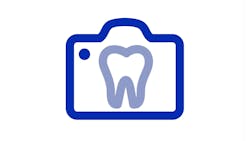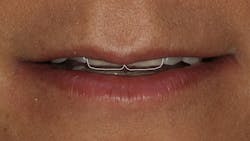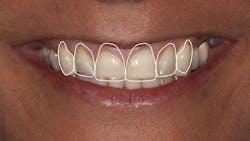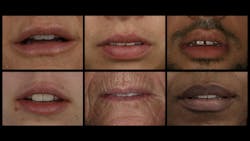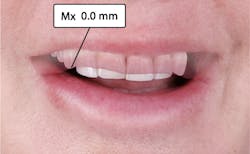Creating Consistency with Charlie and Chris: The importance of the repose photo
We started this series last month by discussing the photos needed for diagnostic planning. We mentioned that the most essential photo is a repose, or lips-at-rest, image. Why is this so critical?
In modern dentistry, we typically start planning with the maxillary incisors. We know from a study by Vig and Brundo that we typically see 1 mm to 4 mm of central incisor display at rest depending on the age and sex of the patient.1 We usually see more display in young females, less as people age, and men typically show slightly less than women.
Using this repose photo, we can set the position of the incisal edges of the centrals (figure 1) and this determines where the other teeth should exist in the smile (figure 2). If we don’t start with this photo and position, we can’t accurately determine the best position for the maxillary teeth.
One of the issues we see when determining the correct amount of display is that there is a lot of lip size and shape variation in people (figure 3). A young female with a high lip curve may look good with 4 mm of incisal display at rest, but an older male may look like a rabbit. Thick lips and thin lips may also present different esthetic challenges when determining proper display. This is where art will need to meet the science, but our 1 mm to 4 mm range will usually put us in the right place.
Other ways the repose photo is valuable
Another way to use the repose photo is to evaluate the position of the maxillary canine. Misch studied the relationship between the vertical position of the maxillary central incisal edge and the maxillary canine relative to the maxillary lip line at rest. His findings suggest that the maxillary canine serves as a reliable reference point for determining the ideal placement of the maxillary incisal edge, especially in edentulous patients.2
This approach is particularly useful when there is significant variation in lip shape. By superimposing the repose photo onto the smile photo, we can visualize the canine position more clearly (figure 4). In most smiles, the tip of the maxillary canine should align with the end of the lip.
By starting with the repose photo, we give ourselves the best chance of getting the maxillary incisal edge position right from the beginning. Understanding how lip dynamics, age, and gender all influence incisal display helps us create natural, esthetic smiles that fit the individual.
As we continue this series, we’ll build on this foundation and explore how to fine tune tooth position using additional photographic and clinical references. Getting the repose photo right is the first step in predictable, facially driven treatment planning!
Editor's note: This article appeared in the April 2025 print edition of Dental Economics magazine. Dentists in North America are eligible for a complimentary print subscription. Sign up here.
References
1. Vig RG, Brundo GC. The kinetics of anterior tooth display. J Prosthet Dent.1978;39(5):502-504.
2. Misch CE. Guidelines for maxillary incisal edge position–a pilot study: the key is the canine. J Prosthet. 2008;7(2):130-134. doi:10.1111/j.1532-849X.2007.00259.x
About the Author

Charlie Ward, DDS
Charlie Ward, DDS, graduated from University of Maryland Dental School in 2008. He is a member of the visiting faculty of The Pankey Institute in Key Biscayne, Florida, where he teaches the Mastering Aesthetics Restorative Dentistry and Dental Photography courses. He also recently joined the faculty for Align Technologies. He practices restorative dentistry in Baltimore, Maryland, with his partner Dr. Devon Conklin, and his wife and periodontist Dr. Melody Ward. He is a member of the Academy of General Dentistry and the American Academy of Cosmetic Dentistry.

Christopher D. Mazzola, DDS
Christopher D. Mazzola, DDS, graduated from the University of Michigan Dental School in 2009. He is a member of the visiting faculty of the Pankey Institute in Key Biscayne, Florida, where he teaches “Essentials 3: Restorative Integration of Form and Function” and “Mastering Dental Photography.” He also recently joined The Dental Advisor team as an evaluator. He practices restorative dentistry in Traverse City, Michigan, in a large fourth-generation practice. He is a member of the Academy of General Dentistry and the American Academy of Cosmetic Dentistry. Contact him on Instagram @christopherdmazzoladds and visit his website at traversedental.com.
